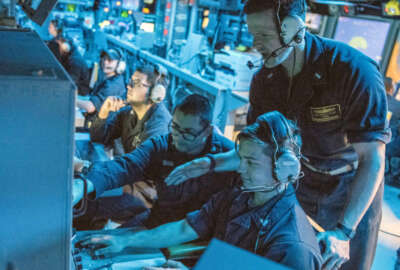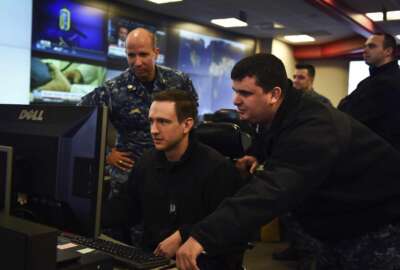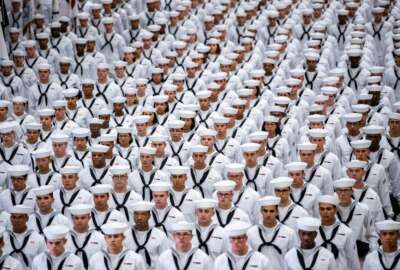
A conversation with the STEM director at the U.S. Naval Academy
The Navy has many things sailors, ships, submarines, airplanes. In some sense, it's a science and technology enterprise.
Best listening experience is on Chrome, Firefox or Safari. Subscribe to Federal Drive’s daily audio interviews on Apple Podcasts or PodcastOne.
The Navy has many things; sailors, ships, submarines, airplanes. In some sense, it’s a science and technology enterprise, you know – STEM. Recently on a visit to the Naval Surface Warfare Center in Dahlgren, Virginia, the Federal Drive with Tom Temin caught up with Joseph McGettigan, a former Navy captain, who’s now director of the STEM center at the Naval Academy.
Interview transcript:
Tom Temin: Tell us more about the STEM center, because I guess I’m a little surprised there’s a STEM center because I would think STEM is endemic to everything that goes on at the academy.
Joseph McGettigan: Many years ago, the Navy figured out that there wasn’t enough STEM majors coming from American universities to fill all the jobs that the Navy would need. So they started to do STEM outreach to middle school kids, high school kids, to try to get them interested in pursuing STEM degrees in college, so that there would be enough available and the Naval Academy, being an educational facility within the Navy was looked at as kind of the best place to run that type of outreach from. So we have a team of people there. That’s what we do. We teach students about STEM subjects, every opportunity we can we try to get them to come to the Naval Academy. So we show everything that is available there. We have tremendous facilities, especially for engineering and math and science. So we tried to showcase that if they get interested in the Naval Academy and want to come to the Naval Academy, that’s an added benefit. But that’s not 100% of what we do. We’re just trying to get them to pursue STEM degrees, and then come to work for DoD, maybe sometime in the future.
Tom Temin: Sure. For the Navy writ large, it must be useful to maybe push STEM even in an NROTC program, because not everyone can go to the Naval Academy,
Joseph McGettigan: Correct. Yes. And we work with a lot of bases around the world, actually, because every one of them will have some type of STEM outreach, whether it’s to a DoD school in another country, or it’s with the local schools around the base. And we try to work with a scientists and engineers that do that type of outreach, to make sure that they have exciting and interesting programs, and can do a really credible job of as I call it plant the seed, you know, and some young mind that, hey, this is really cool. I think I’d like to do that someday.
Tom Temin: What’s your assessment of the quality of the recruits and the people going into STEM from high school or mid-college at this point? Do we still have a pretty good base in the United States?
Joseph McGettigan: We do. And, you know, I keep saying that one of the good parts about being associated with this position is that I get to see those kids. And it kind of reaffirms your faith in the kids that we have in this country, because I get to see some just absolutely amazing kids that have been doing exciting things with engineering and math and science for many, many years. And then they come to the Naval Academy, and you start showing them some of the equipment and some of the facilities and they just take off. Yeah, it is very rewarding.
Tom Temin: Talk about this concept of warrior engineer, because I guess it’s an old concept in the Navy. But because software and digital design and all of these technologies are just taking over what’s behind all of the kinetic activity that warfare entails. Talk about that idea.
Joseph McGettigan: So especially when I was here at Dahlgren. When I was here, 2004 to 2007 as the commanding officer. And you have a lot of these engineers here that really understand how they can impact the fleet. There’s a lot of engineers around the country that do work, but they don’t understand the importance of what it means to the warfighters. And that’s the thing that’s exciting about Dahlgren. And I used to say this a lot that when an engineer at Dahlgren works on something, they understand the urgency that they need to get it to the fleet as soon as possible. So they can help the sailors that are out there now, or potentially save their lives. And an engineer in industry might not have that same timeline, especially the scientists and engineers that are at universities. Sometimes they just want to study something for the sake of studying it. And you know, they would wonder why, I wonder if I modify this, or I wonder if I change that. I wonder if I can do this, again, let’s just try this again, in a different way. As opposed to the engineers that are here. They understand that, no, this is important, this is going to make somebody’s life better. And I need to get this out the door as soon as possible to make it happen.
Tom Temin: And at a place like Dahlgren, of course, you have civilian and uniformed and contractor engineers, and they’re working on firing ranges. You can see the kinetic effects of firing a weapon and what happens and so forth. At the academy, how do you instill that when they don’t get the direct exposure to the effects of what they’re working on that they might later on at a place like Dahlgren?
Joseph McGettigan: So one of the things that’s really exciting about the Naval Academy is they emphasize hands on engineering. So every student there, regardless of what they study, at the end of their four years have to do a capstone project and that capstone project is some hands on project that they can decide what they want to do, they have to get it approved. But they can build something, they can take something that’s already out there, take it apart, study it in some way, they have to do something that’s hands on to take all the things that they’ve learned and put it to use.
Tom Temin: Sure. And we’ve been talking a lot about digital engineering today. And we’ve been talking a lot about hypersonics, and software, revolutionary engineering and so forth, is there still work to be done in the metallurgy, in the explosive and in the chemical aspects of all of this?
Joseph McGettigan: A lot of times we do get enamored with the brand new things, but there is always the aspect of taking what we have, and just making it that much better. So you mentioned metallurgy, you know, having materials that don’t corrode. So again, it makes shipboard life so much better when you don’t have to chip and paint all the time. Sounds, you know, like a simple thing, but it’s actually not. And it does take a lot of time and energy, the ships, they operate in saltwater. So water is always trying to eat away at the hull. So if you can, you know, come up with a better solution it’s always a good thing.
Tom Temin: Sure. And just a little bit more about your own career because you retired from Dahlgren 15 years ago, almost. You’re still a Navy employee, I guess you can take the uniform off, if you can’t take the boy out of the Navy altogether. Tell us about your own history.
Joseph McGettigan: I had a 30-year career in the Navy. I started off as a Surface Warfare Officer, my first ship, I was the ASW officer doing anti-submarine warfare. And just was fascinated by all that. So I went to the Naval Postgraduate School for undersea warfare. And while I was there, I was doing pretty well. And they asked me if I would like to become an engineering duty officer, and do this full time. And that kind of fascinated me, and I thought sounds like a neat option. So I became an engineering duty officer. So then I was always working kind of in between the operational Navy, and the engineers and scientists that were building things. So, you know, I took that operational experience that I had, and I was able to apply it with the engineering background that I had. It’s often that, somebody will develop something that technically is really terrific. But you look at it, and you say that’ll never survive, you know, five minutes on a ship when it’s operating at sea, and you realize an 18 year old kid needs to be able to operate, maintain that piece of equipment. So having that operational experience, I think, was always critical with the engineering background.
Tom Temin: And as a retired officer who spent a lot of time on board, I’ve always wondered, do you never want to set foot on a ship deck again? Or do you love going on cruises? Or do you operate your own boat? How does that effect a person?
Joseph McGettigan: It gets in your blood. It’s a fascinating thing. You know, people used to always say, how can you go out on a ship for nine months, and it’s like, it’s an amazing thing that when you’re out there, and everybody is operating as a team doing the job that they’re trained to do. It’s a wonderful thing. That time just flies by so fast when you’re out there operating. And it’s just a great place to be. It’s a great feeling to know that you’re able to make a difference when you’re out there. And they do feed you pretty well out there. That’s the benefit of the Navy, as opposed to a lot of the other services.
Tom Temin: Right, excellent. Retired Navy Captain Joseph McGettigan, now director of the STEM center at the Naval Academy.
Copyright © 2025 Federal News Network. All rights reserved. This website is not intended for users located within the European Economic Area.
Tom Temin is host of the Federal Drive and has been providing insight on federal technology and management issues for more than 30 years.
Follow @tteminWFED





